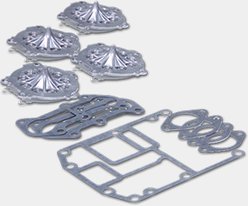According to Mercury Pro Team member Andy Montgomery, who fishes the Major League Fishing Bass Pro Tour, learning to use a baitcaster will improve the skills of any angler. His main contention is that a baitcaster allows you to make more-controlled, smoother casts, which leads to more fish in the boat.
Learn more about the advantages of a baitcasting reel here.
When you're ready to start learning to use a baitcaster, Montgomery has some tips to get started, beginning with learning the most essential types of casts.
“There are a lot of casts with a baitcaster, but there are three basic ones to learn starting out,” he said.
The best way to learn each cast is to watch Montgomery’s demonstrations in the video below. Then apply the following advice to make sure you’re using the right cast for each situation you encounter on the water.
1. The Overhand Cast
The overhand cast is the most basic cast. To do it, swing the rod straight back over your dominant shoulder. The rod needs to “load,” or bend, under the weight of the lure. Once it loads, swing it back forward and release the cast out in front of your body with arms extended. Don’t muscle it. Let the rod do the work.
“I’m going to use this cast to make the longest cast possible, but not when throwing to an exact spot,” Montgomery said. “When I’m fishing spots off the bank, like points, grass flats or where the fish could be anywhere in the area, I use this cast.”
Casting distance is a benefit of the overhand cast. It’s ideal when using crankbaits, swimbaits, jigs or other lures to cover a large area with a single cast.
2. The Roll Cast
When less splash and more accuracy are desired, the roll cast, or sidearm cast, is a solution.
This cast is for shorter, more targeted presentations, like quietly placing a jig next to a stump or dock post. It is called a “roll cast” because the technique is to “roll” the lure around the tip of the rod during the cast. To do it, bring the rod to the side, using your wrists to swing the lure back slightly over the rod tip. Then propel it forward under the rod tip.
A roll cast is where the true benefit of “feathering” the spool of a baitcaster with the thumb comes into play. Use your thumb to slow the spool – and the lure – as the lure is about to reach the surface of the water, so it gently lands without a big splash.
This cast is effective for putting a lure into a tight spot at medium range. It can also be used to present a lure under an obstruction, such as an overhanging limb. With time, you should be able to develop enough touch to drop a lure on a precise spot.
3. The Pitch
Pitching is best for making quiet, precise presentations close to the boat, particularly in tight areas, like around docks or flooded brush. This cast is made almost entirely with the wrist, and the rod stays in front of your body the entire time. It works best when the target is 25 feet or less from the boat.
“Maybe you’re in a group of cypress trees, tight places where it is hard to make that sidearm cast. You can always make short pitches,” said Montgomery.
To do it, let out a few feet of line and hold the lure in your off hand. Keep your elbow on your casting hand in close. Point the rod tip down and toward the target, pulling the line so it’s just tight, then use your casting hand and wrist to swing the lure out in front, with an up-and-away motion. With practice, you should be able to keep the lure traveling close to the water on a flat trajectory, for a near-silent entry into the water.
Next-Level Casting
Once these three casts are learned, more challenging casts become possible. A backhanded roll cast and a skip cast are two that come into play when it’s necessary to present a lure at different angles as quickly as possible.
“If you master these three casts first and then move into these other ones,” said Montgomery, “it’s going to make you a better fisherman.”
Practice Makes Perfect
Learning to use a baitcaster takes time and patience. Backlashes are inevitable. Fellow Mercury Pro Team member Ott DeFoe has some helpful tips on avoiding backlashes and picking out the tangles that can help you through the learning process. As frustrating as backlashes can be, it’s important to push through and keep trying. With practice, you’ll develop the timing and accuracy to make a productive cast nearly every time. And that will help you catch more fish.



























